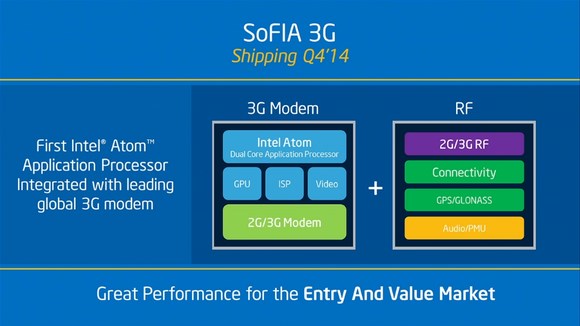Intel Partners With Rockchip To Develop Quad-Core Sofia Mobile Processors For Android Tablets
Intel has announced a new partnership with mobile SoC developer Rockchip, with plans to bring new Android products to China beginning in the first half of 2015. The partnership will use Intel's SoFIA platform with an integrated 3G radio and Atom processor initially, though Intel does plan to deliver a follow-up version of that platform with LTE connectivity later next year. The idea behind the partnership, according to Intel CEO Brian Krzanich, is to leverage Rockchip's market penetration and channel sales and combine them with Intel's own CPU technology.
When asked, Krzanich indicated that Rockchip would provide certain supplementary technology, possibly including the GPU, and said that Intel would also develop a quad-core variant of the SoFIA platform. That's in addition to the company's other SoFIA plans; Intel didn't state whether or not it would be cutting additional deals with other companies or who else might deploy SoFIA devices in 2014-2015.

Like Intel's other SoFIA hardware, the Rockchip branded solution will be built on 28nm technology at TSMC. What's odd about this solution is that it's a team-up where team-ups are unusual -- Samsung may sell Qualcomm parts alongside its own hardware into various markets, but it doesn't usually declare this as a strategic partnership, preferring instead to focus on the supremacy of its own brand. It's doubly unusual for Intel, which noted on its conference call that the devices would have dual Rockchip-Intel branding. Historically, Intel has played up its own branding extensively (its old marketing efforts in the height of the PC era required that all PC manufacturers include the Intel logo and characteristic jingle.
During the call, Intel implied it would focus on bringing Android devices out in the sub-$150 to sub-$100 segments, which is a new focus for the company but a good fit for the lower-end SoFIA devices. Historically Intel eschewed such markets for its tablets and smartphone efforts and targeted devices with substantially higher MSRPs. When x86 tablets first debuted, the original goal was to position them as low-cost alternatives to ARM devices at higher price points with better feature sets and compatibility.
If Intel is going to push SoFIA into these lower price points, it means the company is finally willing to go toe-to-toe with Android on price. It won't be competitive with most ARM tablets until SoFIA picks up LTE support, but 3G should be good enough for the low-end market through the first half of 2015. Intel has previously said that it will transition back to building its own mobile devices (with onboard integrated LTE modem) in the 2015-2016 time frame. These products will be deployed on 14nm or lower geometries and are expected to lead Intel's next attack on the higher end of the mobile market.
When asked, Krzanich indicated that Rockchip would provide certain supplementary technology, possibly including the GPU, and said that Intel would also develop a quad-core variant of the SoFIA platform. That's in addition to the company's other SoFIA plans; Intel didn't state whether or not it would be cutting additional deals with other companies or who else might deploy SoFIA devices in 2014-2015.

Like Intel's other SoFIA hardware, the Rockchip branded solution will be built on 28nm technology at TSMC. What's odd about this solution is that it's a team-up where team-ups are unusual -- Samsung may sell Qualcomm parts alongside its own hardware into various markets, but it doesn't usually declare this as a strategic partnership, preferring instead to focus on the supremacy of its own brand. It's doubly unusual for Intel, which noted on its conference call that the devices would have dual Rockchip-Intel branding. Historically, Intel has played up its own branding extensively (its old marketing efforts in the height of the PC era required that all PC manufacturers include the Intel logo and characteristic jingle.
During the call, Intel implied it would focus on bringing Android devices out in the sub-$150 to sub-$100 segments, which is a new focus for the company but a good fit for the lower-end SoFIA devices. Historically Intel eschewed such markets for its tablets and smartphone efforts and targeted devices with substantially higher MSRPs. When x86 tablets first debuted, the original goal was to position them as low-cost alternatives to ARM devices at higher price points with better feature sets and compatibility.
If Intel is going to push SoFIA into these lower price points, it means the company is finally willing to go toe-to-toe with Android on price. It won't be competitive with most ARM tablets until SoFIA picks up LTE support, but 3G should be good enough for the low-end market through the first half of 2015. Intel has previously said that it will transition back to building its own mobile devices (with onboard integrated LTE modem) in the 2015-2016 time frame. These products will be deployed on 14nm or lower geometries and are expected to lead Intel's next attack on the higher end of the mobile market.

